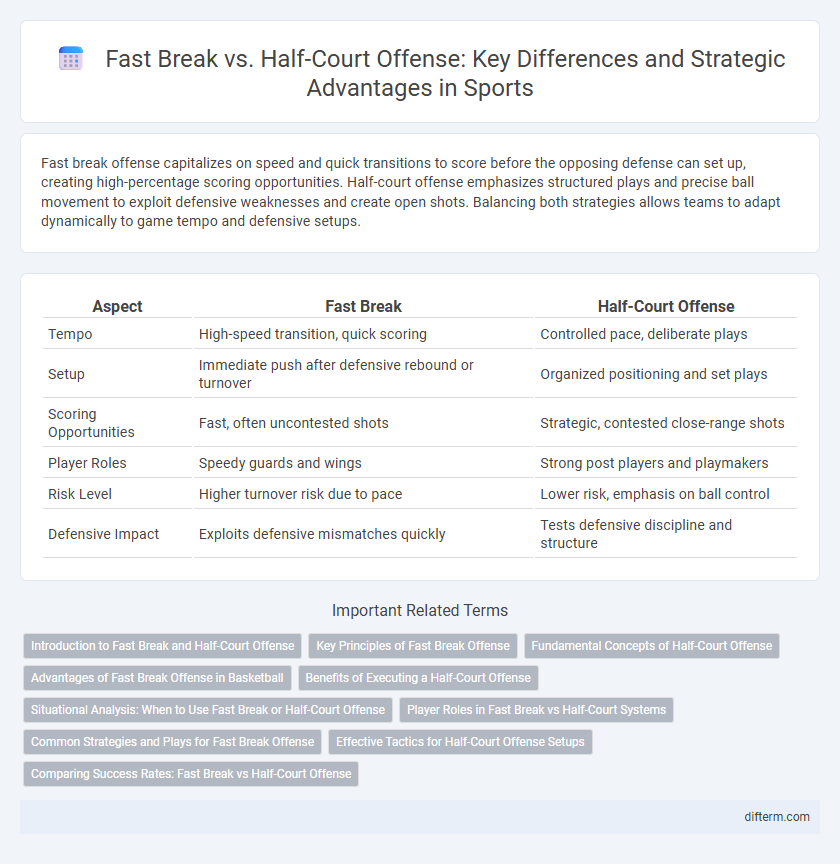Fast break offense capitalizes on speed and quick transitions to score before the opposing defense can set up, creating high-percentage scoring opportunities. Half-court offense emphasizes structured plays and precise ball movement to exploit defensive weaknesses and create open shots. Balancing both strategies allows teams to adapt dynamically to game tempo and defensive setups.
Table of Comparison
| Aspect | Fast Break | Half-Court Offense |
|---|---|---|
| Tempo | High-speed transition, quick scoring | Controlled pace, deliberate plays |
| Setup | Immediate push after defensive rebound or turnover | Organized positioning and set plays |
| Scoring Opportunities | Fast, often uncontested shots | Strategic, contested close-range shots |
| Player Roles | Speedy guards and wings | Strong post players and playmakers |
| Risk Level | Higher turnover risk due to pace | Lower risk, emphasis on ball control |
| Defensive Impact | Exploits defensive mismatches quickly | Tests defensive discipline and structure |
Introduction to Fast Break and Half-Court Offense
Fast break offense in basketball emphasizes rapid transitions and quick scoring before the opposing defense sets up, leveraging speed and spacing to create high-percentage shots. Half-court offense relies on structured plays and coordinated ball movement within the offensive half, aiming to exploit defensive gaps through pick-and-rolls and post plays. Effective use of fast breaks increases scoring opportunities, while half-court strategies focus on precise execution and maximizing possession efficiency.
Key Principles of Fast Break Offense
Fast break offense emphasizes speed, spacing, and quick decision-making to capitalize on defensive disarray before it sets up. Key principles include aggressive ball handling, immediate outlet passes after rebounds, and players sprinting the court to create numerical advantages. Efficient execution relies on seamless transition from defense to offense, exploiting gaps through rapid dribbling, precise passing, and timely cuts toward the basket.
Fundamental Concepts of Half-Court Offense
Half-court offense emphasizes spacing, ball movement, and player positioning to create high-percentage scoring opportunities through set plays and screens. It relies on precise timing and coordinated actions to exploit defensive gaps while maintaining control and minimizing turnovers. Mastery of fundamental concepts like pick-and-roll, off-ball movement, and shot selection is essential for effective execution and sustained offensive efficiency.
Advantages of Fast Break Offense in Basketball
Fast break offense in basketball maximizes scoring opportunities by capitalizing on the opponent's defensive transition weaknesses, often resulting in high-percentage shots near the basket. This strategy increases game tempo, forcing the opposing team to expend more energy and potentially commit defensive lapses. Utilizing speed and quick decision-making, fast breaks can shift momentum and create psychological pressure on opponents.
Benefits of Executing a Half-Court Offense
Executing a half-court offense enables a team to maintain structured ball movement, increasing scoring opportunities through precise pick-and-rolls and strategic spacing. This approach minimizes turnovers by reducing rushed plays and emphasizes exploiting mismatches to create high-percentage shots. Teams proficient in half-court sets often dominate time of possession, wearing down defenses and controlling the game's pace.
Situational Analysis: When to Use Fast Break or Half-Court Offense
Fast break is most effective during transitions when the opposing defense is disorganized, allowing quick scoring opportunities before opponents set up. Half-court offense is ideal in late-game situations or against teams with strong transition defense, emphasizing set plays and strategic ball movement to create high-percentage shots. Coaches analyze game tempo, player stamina, and defensive alignment to decide between exploiting fast breaks or controlling the pace with half-court sets.
Player Roles in Fast Break vs Half-Court Systems
In fast break offenses, primary ball handlers push the pace while wings and forwards sprint for quick scoring opportunities, emphasizing speed and court spacing. Half-court systems require post players to establish position for screens and rebounds, while guards execute set plays and create shot opportunities through precise passing and strategic movement. Each role adapts to maximize efficiency, with fast breaks capitalizing on transition speed and half-court offenses focusing on coordinated team dynamics.
Common Strategies and Plays for Fast Break Offense
Fast break offense in basketball emphasizes quick transitions and exploiting numerical advantages before the defense sets up, commonly involving outlet passes and immediate dribble penetration. Key strategies include pushing the ball upcourt via the point guard, utilizing wings for quick catches and finishes, and orchestrating trailer runs for open three-point attempts or dunks. Effective fast break plays rely on speed, spacing, and precise timing to maximize scoring opportunities in less than 10 seconds after a defensive rebound or turnover.
Effective Tactics for Half-Court Offense Setups
Effective half-court offense setups rely on precise spacing and intelligent player movement to create high-percentage scoring opportunities despite the defense's structured formation. Utilizing pick-and-roll plays, off-ball screens, and quick ball reversals disrupts defensive schemes and opens lanes for shooters and cutters. Emphasizing patience, ball movement, and exploiting mismatches are critical tactics to enhance scoring efficiency in half-court scenarios.
Comparing Success Rates: Fast Break vs Half-Court Offense
Fast break offense yields higher scoring percentages due to quicker shots taken before the defense sets up, often averaging around 60-70% success in transition plays. In contrast, half-court offense typically results in lower shooting percentages, ranging from 40-50%, as it relies on structured plays and defensive pressure increases shot difficulty. Teams with strong athleticism and conditioning tend to exploit fast breaks more effectively, while disciplined teams excel in half-court execution and shot selection.
Fast break vs half-court offense Infographic

 difterm.com
difterm.com